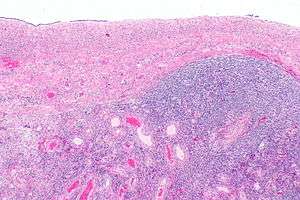Ovarian serous cystadenoma
Ovarian serous cystadenoma, also (less precisely) known as serous cystadenoma, is the most common ovarian neoplasm, representing 20% of ovarian neoplasms, and is benign.[1]
| Ovarian serous cystadenoma | |
|---|---|
 | |
| Ovarian serous cystadenoma. The cystic space is at the top of the image. Ovarian parenchyma is seen at the bottom right. H&E stain. | |
| Specialty | Oncology |
It has a very superficial resemblance to the most common type of ovarian cancer (serous carcinoma of the ovary) under the microscope; however, (1) it is virtually impossible to mix-up with its malignant counterpart (serous carcinoma), and (2) does not share genetic traits of indeterminate serous tumours, also called serous borderline tumours, that may transform into serous carcinoma.[2]
Serous cystadenomas (of the ovary) are not related to serous cystadenomas of the pancreas, i.e. the presence of an ovarian or pancreatic one does not suggest an increased risk for the other one.
Diagnostic Procedures includes initially ultrasound or colour doppler study to know about size and nature of mass and sometimes CECT. Blood investigation includes CA 125 level for screening and further CEA, beta hCG levels, AFP, CA19-9, LDH level to confirm diagnosis. And before going to surgery routine investigation to be done.
Diagnosis
Serous cystadenomas are diagnosed by histomorphologic examination, by pathologists. Grossly, they are, usually, unilocular cysts that contain clear, straw-coloured fluid. Microscopically, the cyst lining consists of a simple epithelium with cilia that may be columnar or flat.
Microscopical images
Epidemiology
Ovarian serous cystadenoma accounts for the largest proportion of benign ovarian tumours, making up over 50-80% of all malignant epithelial ovarian tumours. Its prevalence peaks between 60-70 years of the human lifespan. Serous ovarian cystadenocarcinomas account for ~25% of serous tumours.[3]
References
- Human Reproduction. University of Utah Medpath http://library.med.utah.edu/kw/human_reprod/seminars/seminar4B2.html.
- Cheng, EJ.; Kurman, RJ.; Wang, M.; Oldt, R.; Wang, BG.; Berman, DM.; Shih, IeM. (Jun 2004). "Molecular genetic analysis of ovarian serous cystadenomas". Lab Invest. 84 (6): 778–84. doi:10.1038/labinvest.3700103. PMID 15077125.
- Radswiki. "Ovarian serous cystadenocarcinoma | Radiology Reference Article | Radiopaedia.org". Radiopaedia. Retrieved 2019-09-21.





